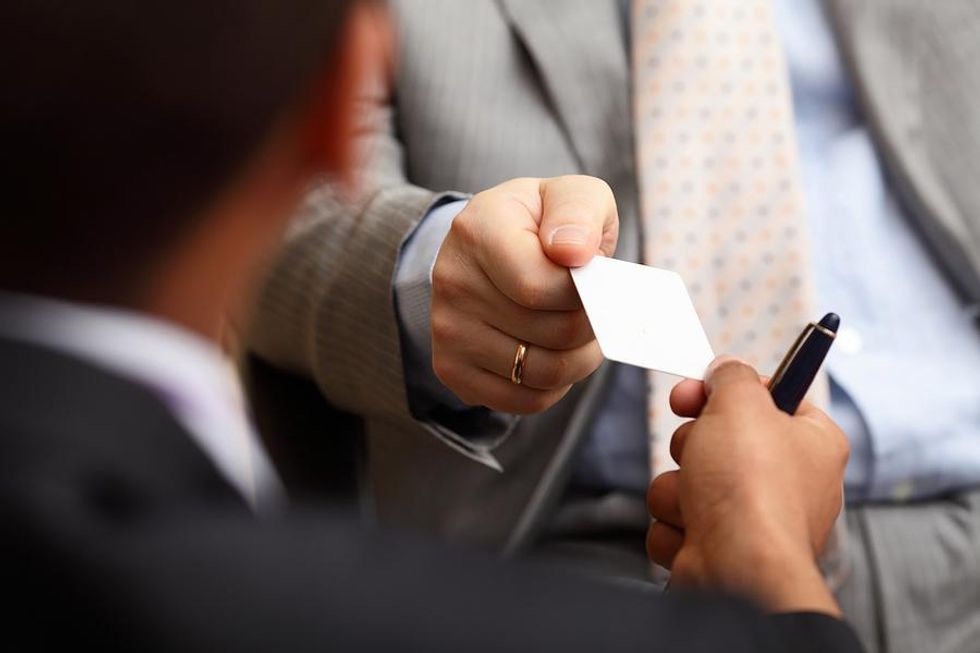
Yes, there's such a thing as business card etiquette when networking. Don't mess it up!
Suppose you were out having lunch with a new business acquaintance and when your food was delivered to the table, your lunch partner reached over with her hand and sampled your meal. What would you think? That they were rude—lacking proper social etiquette, right? You'd be offended and probably lose your appetite. Besides ranking their social grace at zero, you'd also seriously question their professional competence as well.
The example I shared above is extreme. But here's the point: All it takes is one wrong move to jeopardize your professional image.
At live networking events, where you only have 30 seconds to make a good first impression, you cannot afford to make the wrong move. Regardless of how shallow it may seem, the world first judges us on how we appear. It's more than looks and clothes—it's demeanor, presence, body language, and how confident you appear engaging with others. And all of that can be picked up on in a first glance or notice, or with the first handshake.
So, let's say you are dressed well, your confidence is high, and your body language is clearly communicating you are a person worth knowing. You're 50% there. I've seen well-dressed people still leave a bad impression (even if the first one was good) because of bad networking etiquette. Some of the worst mistakes I see at networking events are people not understanding how to use their business cards.
Here are a few rules for smart business card etiquette to keep in mind at future networking events.Rule #1: Keep Your Business Card To Yourself

Bigstock
DO NOT hand out your business card to everyone you see as if you are passing out $20 bills. Have you ever had someone come up to you while you are talking to someone else and slip a business card in your hand and keep moving? Not only is it distracting, especially if the two people are making a great connection, it is also annoying. It's the equivalent to receiving junk mail at your house. Unless you asked for information about the Tremble 3500 vacuum cleaner, chances are you are not going to joyfully read the advertisement that came in the mail—especially if you are as busy as most of us are.
You ask: But shouldn't the goal be to get my name and contact info in front of as many people as possible?
Answer: Yes, and that is what advertising is for.
Get a billboard, take out an ad, get a web page. But do not fool yourself into thinking that you successfully networked with a hundred people because you handed out a hundred business cards.
One of the goals of networking is to identify qualified leads, potential employers, or referral sources. That doesn't mean that you don't meet and talk to people outside of those targets. But it does mean you are selective about who you choose to exchange information with. In your career, quality is always better than quantity.
Rule #2: Give Your Business Card To Someone When They Ask For It

Bigstock
If I am interested in connecting with someone beyond an event, I will ask for a way to contact them. Notice that I did not say I will give them my card or give them my contact information. Why? If I give them my card, I have no control over whether they will contact me or not. If I get their information, I can follow up with a phone call, via email, or by connecting with them on LinkedIn. Passing out my card to 20 people does not mean that I will get 20 calls. But acquiring contact information of 20 people guarantees that I will have 20 people to add to my follow-up list.
Quick Tip: When someone asks for your business card, write a note on the back of it before you hand it over. It could be a note about what you talked about, a reminder about why they asked for your information. Something that jogs their memory as they go through the sea of cards they have in their collection.
Rule #3: Don't Waste Contact Information

Bigstock
Why take someone's card if you are not going to follow up? Send an email. Make a quick call. Send them a connection request on LinkedIn. Do something to capitalize on the meeting.
This doesn't have to be complicated. Entrepreneurs can send updates about new products or developments in their business. Professionals can share articles and tips on LinkedIn that are relevant to their industry.
You ask: But can't I just keep the card in case I need their assistance later?
Answer: Yes you can. But it seems more likely and more wise that if you needed assistance from someone you didn't already have in your network that you would ask someone you know for a referral rather than choosing a random card from your stack.
Don't make the assumption that just because you have their card, that the business or individual is a part of your network—especially if you have no experience with the quality of their work or haven't connected and built a professional relationship with them.

The take away:
- Keep your business card to yourself until someone asks for it.
- Only ask for cards or contact information for people you intend to follow up with.
- Make the most of your networking strategy by regularly connecting with your contacts.
Happy networking!
Need more help figuring out your networking strategy? We're here for you!
Check out our FREE resources page and Live Events Calendar.
Or, join our career growth club today and get access to one-on-one career coaching, resume and cover letter reviews, online tutorials, and unlimited networking opportunities—all in your back pocket!
If you want FREE career advice in your inbox, subscribe to our newsletter The Daily Dose!
This post was originally published at an earlier date.
- JT Talks Jobs - How To Successfully Network During COVID-19 ... ›
- Remote Networking: 3 Tips For Professionals & Job Seekers - Work ... ›
- 3 Reasons Why Your Networking Strategy Isn't Working - Work It ... ›
- 4 Ways To Win At Networking ›
- JT Talks Jobs - Can't Pay Mortgage Due to COVID-19? Do This - Work It Daily ›

 Bigstock
Bigstock Bigstock
Bigstock Bigstock
Bigstock


